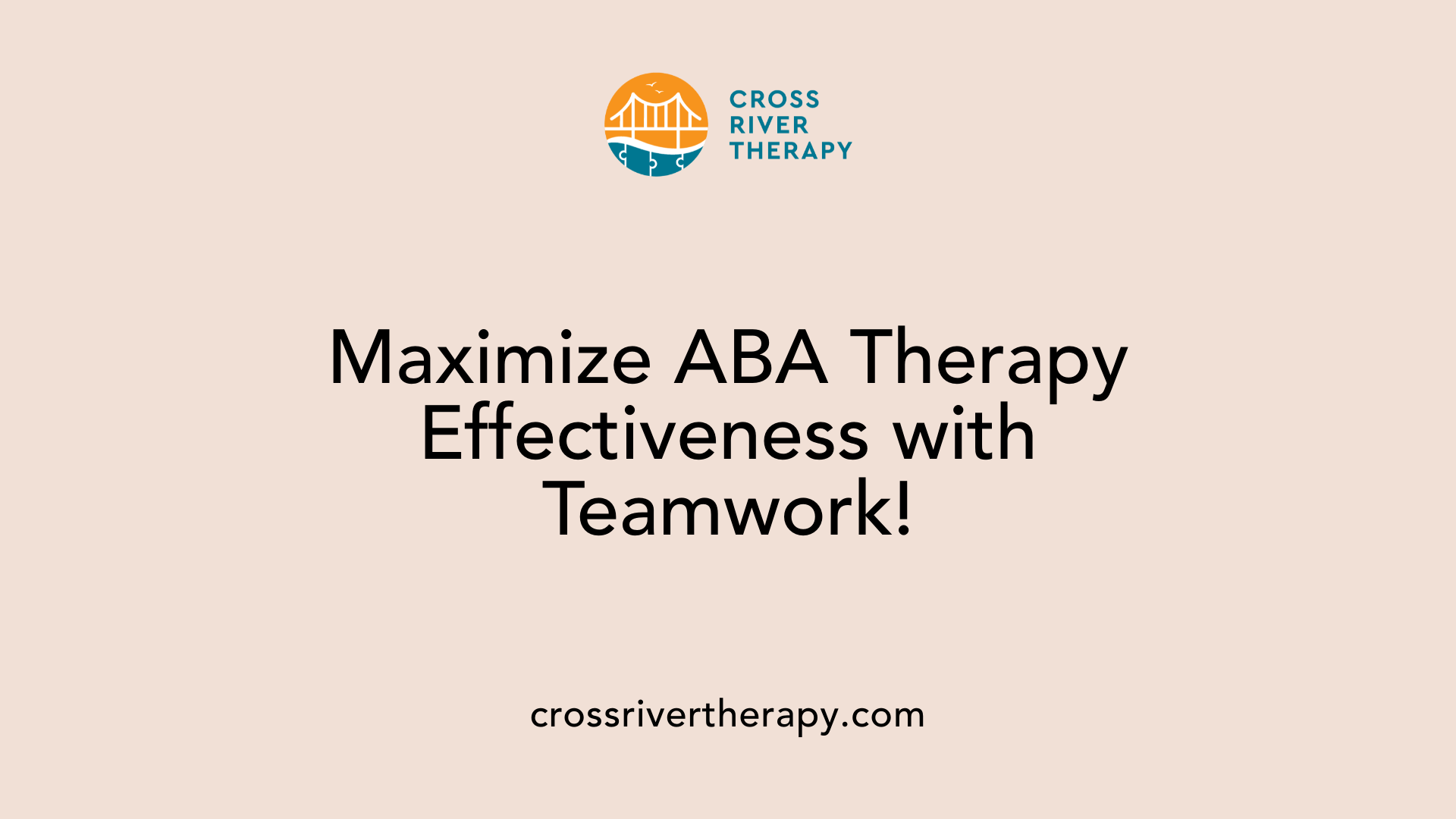The Importance of a Team Approach in ABA Therapy
Enhancing Autism Treatment Through Collaborative ABA Therapy
Introduction
Applied Behavior Analysis (ABA) therapy is a cornerstone in addressing the needs of individuals with Autism Spectrum Disorder (ASD). However, its effectiveness amplifies significantly with a team-based, multidisciplinary approach, which brings together diverse expertise to create a comprehensive treatment plan. This article delves into the importance of collaboration in ABA therapy, how it enhances therapeutic outcomes, and the crucial roles played by different specialists and family members in the process.
The Core Dimensions of Effective ABA Programs

What are the 7 dimensions that define successful ABA programs?
The success of Applied Behavior Analysis (ABA) programs can be defined by seven key dimensions:
- Applied: This dimension focuses on selecting behaviors that are socially significant and will positively impact the individual's life.
- Behavioral: Targets behaviors must be observable and measurable, allowing for clear assessments of progress.
- Analytic: Interventions must be based on evidence and demonstrate a solid connection between applied strategies and observable changes in behavior.
- Technological: All procedures and interventions should be precisely documented to ensure consistency in implementation across different providers and settings.
- Conceptually Systematic: Interventions should systematically apply established principles of behavior analysis, ensuring that practices are grounded in theory and research.
- Effective: The interventions employed must result in meaningful and practical behavior changes that can be seen in the individual's daily life.
- Generality-oriented: Skills learned should be transferable and applicable in various environments, ensuring that the benefits of ABA extend beyond therapy sessions.
Each of these dimensions plays a vital role in ensuring that ABA programs not only meet the unique needs of individuals receiving therapy but also lead to significant and lasting improvements in their quality of life.
Why ABA is the Gold Standard for Autism Treatment

What is the gold standard treatment for autism?
Applied Behavior Analysis (ABA) is overwhelmingly recognized as the gold standard treatment for autism. This designation stems from its robust research foundation and proven effectiveness in addressing the unique needs of children with this developmental disorder. The Centers for Disease Control and Prevention (CDC) highlights the pressing need for therapies like ABA, noting that approximately 1 in 44 children in the U.S. is diagnosed with autism.
Both the American Medical Association (AMA) and the American Psychological Association (APA) support ABA, endorsing its principles and methodologies as safe and effective. These endorsements underline the importance of having evidence-based strategies in place to assist those on the autism spectrum, emphasizing the therapeutic benefits that have been documented through extensive research.
Additionally, the National Coalition for Autism Services (NCAAS) plays a critical advocacy role for ABA therapy. They strive to preserve and expand access to ABA, recognizing the mounting demand for quality treatment. Collaborating with insurers and policymakers, the NCAAS works to ensure that families can access affordable ABA services in a timely manner, thus reinforcing the therapy's accessibility and relevance in today’s healthcare landscape.
Collaboration: The Backbone of Successful ABA Therapy

Why is collaboration important in ABA therapy?
Collaboration is vital in ABA therapy because it brings together a diverse team, including Board-Certified Behavior Analysts (BCBAs), speech-language pathologists, occupational therapists, parents, teachers, and pediatricians, to create comprehensive and tailored treatment plans. Each team member contributes unique insights into the child's challenges and strengths, enhancing the overall therapeutic experience and effectiveness of interventions.
Parents play a crucial role by applying strategies at home, ensuring consistency and reinforcement of positive behaviors. Their involvement not only bridges therapy findings into daily routines but also promotes generalization of skills across different environments.
Additionally, specialized techniques such as discriminative stimuli increase the specificity of interventions, helping children with autism make connections between cues and desired behaviors. This targeted approach fosters skill development, crucial for their overall progress.
Furthermore, by combining expertise from various fields like speech therapy and occupational therapy, multidisciplinary teams can address communication skills, social interaction, and adaptive behaviors holistically. Ultimately, this collaborative approach significantly enhances treatment outcomes, leading to noticeable improvements in behavior and skill acquisition over time.
The Multifaceted Role of a Multidisciplinary Team
What is the role of a multidisciplinary team in ABA therapy?
In ABA therapy, a multidisciplinary team plays a vital role in ensuring comprehensive support for the child. This team usually comprises various professionals, including Board Certified Behavior Analysts (BCBAs), speech-language pathologists, occupational therapists, special educators, and family members. Each member brings unique skills and perspectives, which are essential for tailoring interventions to meet the individual needs of children.
The collaboration process begins with assessing the child's needs, where each specialist shares insights from their respective disciplines. This helps in developing individualized treatment plans that focus on enhancing social, communication, and adaptive skills while reducing challenging behaviors.
Regular communication among team members is crucial. It promotes consistency in interventions across different settings, be it home or school, and ensures that the strategies remain aligned with the child’s evolving needs. Furthermore, involving family members in the treatment plan is vital, as their insights enhance the understanding of the child’s behaviors in various environments.
By integrating diverse perspectives and expertise, the multidisciplinary team significantly enhances the effectiveness of ABA therapy, leading to improved developmental outcomes for children with Autism Spectrum Disorder (ASD) and other developmental conditions. This collaborative effort not only boosts the child's skill acquisition but also fosters their overall developmental progress.
Boosting ABA Therapy's Effectiveness Through Teamwork

How does a team-based approach improve the effectiveness of ABA therapy?
A team-based approach enhances the effectiveness of ABA therapy by bringing together professionals with varying expertise, such as behavior analysts, speech therapists, and occupational therapists. This collaboration ensures that each child's unique needs are met through customized strategies that address different developmental aspects.
Teams composed of Board Certified Behavior Analysts (BCBAs), Speech-Language Pathologists (SLPs), and Occupational Therapists (OTs) actively share their knowledge and skills. For instance, SLPs focus on communication interventions, while OTs work on skills related to daily living. By integrating insights from these disciplines, a more comprehensive treatment plan is developed.
What are the benefits for clients?
Enhanced collaboration in ABA therapy leads to numerous benefits for clients:
- Increased Consistency: Regular communication among team members fosters consistency in the application of interventions across various environments such as home and school.
- Holistic Development: A multidisciplinary approach facilitates the focus on cognitive, motor, and social skills, ensuring a well-rounded developmental support structure.
- Empowered Families: Family involvement allows caregivers to reinforce learned skills, promoting better generalization of behaviors in real-world situations.
- Improved Outcomes: Research has shown that children in multidisciplinary settings achieve developmental milestones more effectively, showcasing the success of well-coordinated care.
In conclusion, the collaboration among specialists not only enriches the therapy experience but also significantly boosts the potential for positive outcomes in children with autism.
Elements of Successful Collaboration in ABA

What are the key elements for successful collaboration in ABA therapy?
Successful collaboration in ABA therapy is essential for effective outcomes and involves several vital elements.
Clear Communication: All team members, including therapists, educators, and family members, must engage in open dialogue. This ensures that everyone is aligned with the treatment plan and understands each child's needs.
Shared Goals: Establishing common objectives allows for a unified focus on improving the child's behavior and skills. Team members can coordinate their efforts effectively to support the child's development.
Mutual Respect: Fostering respect among professionals encourages an environment where diverse perspectives are valued. This variety can significantly enhance the therapy process by incorporating multiple strategies and insights.
Active Family Involvement: Families play a crucial role in the therapy process. Their involvement promotes consistency in intervention strategies, helping reinforce skills learned in therapy sessions at home and in other settings.
Coordinated Care: A multidisciplinary approach facilitates communication among all specialists involved in the care of the child. This coordination helps address the complex needs of children with ASD effectively.
These elements create a strong support system necessary for achieving positive therapeutic outcomes.
Conclusion
The integration of a team-based approach in ABA therapy is not only beneficial but essential for achieving optimal outcomes for individuals with autism. Through the collaborative efforts of a multidisciplinary team, encompassing both professionals and family members, ABA therapy becomes more effective, providing comprehensive care tailored to the unique needs of each child. This article underscores the significance of such teamwork, emphasizing its role in facilitating significant behavioral and developmental progress. As we advance in the field of autism treatment, the emphasis remains on fostering collaboration to harness the full potential of ABA therapy.
References
- Benefits of a Multidisciplinary Approach to ABA Therapy
- ABA Therapy Center's Multidisciplinary Team Approach
- The Team Approach to Educating Students with Autism
- How Our ABA Team Connects with Your Child's School for Further ...
- The Collaborative Approach: ABA - Circle Care Services
- A Behavior-Analytic Perspective on Interprofessional Collaboration
- Benefits of a Team Approach - Bancroft
- The Power Of Multidisciplinary Team And ABA Therapy
- How To Take A Collaborative Approach With Your Care Team



